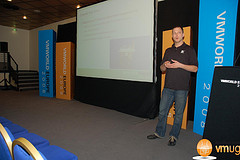SxS is a relatively new OS feature supported by Windows on XP, Windows 2003, and Vista. SxS is a mustâ?have feature in order to deploy most modern software products such as Microsoft Office 2007, Adobe Reader 8, and .NET 2.0/3.0. VMware Project North Star (Thinstall) is the only application virtualization solution which supports SxS. In the early days Microsoft recommend installing DLLs to c:\windows\system32 if you wanted to share them with other applications. This lead to âDLL Hellâ? since one applications installer would install one version of a DLL and another installer would install another version overwriting the existing DLL. If the new version of the DLL wasnât compatible the older application would suddenly break and stop working. This is still how the majority of applications install their DLLs, even Office 2007 installs approximately 7 DLLs to c:\windows\system32. Slowly the industry is moving to deploy shared DLLs using SxS as XP becomes mainstream and Visual Studio 2005 forces this on you if you want to use the Version 8 C Runtime libraries. With SxS technology, applications can install DLLs to version specific directories tell Windows what version of the DLL should be used when they load a DLL by that name. VMware is proud to announce the VMware Project North Star Beta (Thinstall). New features at general availability (GA) will include dynamic linking between "virtual packages" (Application Link) and over the wire updates via HTTP/HTTPS to update deployed virtual applications (Application Sync). Download the VMware Project North Star Beta (Thinstall) today.
Sunday, March 2. 2008
How to predict future capacity bottlenecks
![]()
Alex Bakman, the founder and CEO of Vkernel announced the beta of the Capacity Bottleneck Analyzer on his weblog.
Your virtual data center is growing. You are adding a ton of new VMs every week. Wouldn't it be really cool if you head a "crystal ball" that told you in how many days you will run into capacity bottlenecks and what type of bottlenecks it will be (cpu, memory, storage) ? Now you can. Join Vkernel's beta program for Capacity Bottleneck Analyzer that will kick off in early March.
Upcoming Vizioncore Webinars hosted by Larry Loucks
Larry Loucks, CISSP/VCP/VCI/SCP/MCSE, is a 22-year veteran of the IT industry who has served in many capacities including Novell/Microsoft/Cisco engineering, network design and optimization, and security consulting. During the past 10 years, Larry has worked in consulting with an aim toward improving infrastructure performance while lowering costs of IT to business. Larry joined the virtualization industry around four years ago, and is a former VMware Senior Consultant.
| March 4: vCharter Overview |
| March 6: vRanger Pro 3.2 Overview |
| March 11: vReplicator Overview |
| March 13: vConverter Overview |
| March 18: vRanger Pro 3.2 & VCB |
Thursday, February 28. 2008
Ernst Cozijnsen : âWe practice what we preach�?
 Ernst Cozijnsen and John van der Sluis, two of my colleagues over at Capgemini Outsourcing presented at the VMWORLD EUROPE 2008 in Cannes. Their presentation is called âWe practice what we preachâ? and is all about the success story of implementing a Virtual Infrastructure as a Business Critical solution. By combining intimacy, industrialization and innovation Capgemini Outsourcing has set a footprint on the world of Virtual Infrastructures. Due to extensive research a new architectural vision was created for this Business Critical solution. This new architectural blueprint is based on multiple datacenter with architectural principles like pay-per-use, flexibility, scalability and standardization. With installing new and migrating existing customers this multi vendor infrastructure lead to a growth of over 1600% last year. With shared architectural building blocks a custom solution can now be realized for any environment and future challenges. Capgemini Outsourcing offers dual site and disaster recovery at a lower cost by creating a new version of on-demand scalability for new customer potential. (Picture from Viktor van den Berg)
Ernst Cozijnsen and John van der Sluis, two of my colleagues over at Capgemini Outsourcing presented at the VMWORLD EUROPE 2008 in Cannes. Their presentation is called âWe practice what we preachâ? and is all about the success story of implementing a Virtual Infrastructure as a Business Critical solution. By combining intimacy, industrialization and innovation Capgemini Outsourcing has set a footprint on the world of Virtual Infrastructures. Due to extensive research a new architectural vision was created for this Business Critical solution. This new architectural blueprint is based on multiple datacenter with architectural principles like pay-per-use, flexibility, scalability and standardization. With installing new and migrating existing customers this multi vendor infrastructure lead to a growth of over 1600% last year. With shared architectural building blocks a custom solution can now be realized for any environment and future challenges. Capgemini Outsourcing offers dual site and disaster recovery at a lower cost by creating a new version of on-demand scalability for new customer potential. (Picture from Viktor van den Berg)
Wednesday, February 27. 2008
VMware VMsafe more secure than physical environments
 The new VMware VMsafe Technology Allows the Virtual Datacenter to Be More Secure Than Physical Environments. Twenty Industry-Leading Security Vendors, Including CheckPoint, McAfee and Symantec, Endorse VMsafe Technology and Announce Plans to Build Interoperable Security Solutions. The global leader in virtualization solutions from the desktop to the datacenter, today announced new security technology called VMware VMsafe(tm) that protects applications running in virtual machines in ways previously not possible in physical environments. The VMsafe APIs allow vendors to develop advanced security products that combat the latest generation of malware. VMsafe technology integrates into the VMware hypervisor and provides the transparency to prevent threats and attacks such as viruses, trojans and keyloggers from ever reaching a virtual machine. Twenty security vendors have embraced VMsafe technology and are building products that will further enhance the security of virtual machines, making the virtual environment unmatched in the level of security and protection it provides compared to physical systems.
The new VMware VMsafe Technology Allows the Virtual Datacenter to Be More Secure Than Physical Environments. Twenty Industry-Leading Security Vendors, Including CheckPoint, McAfee and Symantec, Endorse VMsafe Technology and Announce Plans to Build Interoperable Security Solutions. The global leader in virtualization solutions from the desktop to the datacenter, today announced new security technology called VMware VMsafe(tm) that protects applications running in virtual machines in ways previously not possible in physical environments. The VMsafe APIs allow vendors to develop advanced security products that combat the latest generation of malware. VMsafe technology integrates into the VMware hypervisor and provides the transparency to prevent threats and attacks such as viruses, trojans and keyloggers from ever reaching a virtual machine. Twenty security vendors have embraced VMsafe technology and are building products that will further enhance the security of virtual machines, making the virtual environment unmatched in the level of security and protection it provides compared to physical systems.
Virtualization.com interviews Richard Garsthagen
 Virtualization.com interviews Richard Garsthagen, Organizer of VMworld Europe 2008 and VMware Evangelist Cannes, France and experienced virtualization industry event organizer, VMware Evangelist and coordinator of several TSX Events for VMware. Interviewer: Tarry Singh of http:// Virtualization.com bloggers Tarry Singh and Nicolas 'Charbax' Charbonnier sit down with Richard Garsthagen, organizer of the VMWorld Europe 2008 Summit in Cannes, France and experienced virtualization industry event organizer, VMware Evangelist and coordinator of several TSX Events for VMware.
Virtualization.com interviews Richard Garsthagen, Organizer of VMworld Europe 2008 and VMware Evangelist Cannes, France and experienced virtualization industry event organizer, VMware Evangelist and coordinator of several TSX Events for VMware. Interviewer: Tarry Singh of http:// Virtualization.com bloggers Tarry Singh and Nicolas 'Charbax' Charbonnier sit down with Richard Garsthagen, organizer of the VMWorld Europe 2008 Summit in Cannes, France and experienced virtualization industry event organizer, VMware Evangelist and coordinator of several TSX Events for VMware.
Pictures from the VMworld Europe Cannes
 Viktor van den Berg has taken some pictures at VMworld Europe 2008 and the official Dutch VMUG Gettogether in Cannes. Stay tuned at his Flickr landing page because more will follow.
Viktor van den Berg has taken some pictures at VMworld Europe 2008 and the official Dutch VMUG Gettogether in Cannes. Stay tuned at his Flickr landing page because more will follow.
Thursday, February 21. 2008
VI 3.5 Plugin and Extension Programming Guide
The VMware Infrastructure 3.5 Plugin and Extension Programming Guide - Revision 1 is now available at VIPlugins.com. This document is not sponsored or supported by VMware in any way. This paper focuses on educating developers on:
Client Plugin Architecture
This includes where plugins are installed, how the VI client discovers local plugins and ones advertised on the VC server, and finally how to create a client plugin.
Server Extension Architecture
Includes how to register server extensions and how to make client plugins centrally available.
Tomcat Architecture
Discusses how the VirtualCenter Tomcat installation impacts server extension daemons.
Database Schema
Review the new VirtualCenter database tables that are related to extensions.
Creating Windows Installers
Reveals some problems with creating Windows Installers for server extensions.
Namespaces
Details the namespaces and assemblies VMware provides to create plugins and extensions.
Terminology
Coins new terminology that developers can use when discussing the above concepts.
Wednesday, February 20. 2008
How to Identify Capacity Bottlenecks Workshop
 Imagine being able to instantly identify capacity bottlenecks on hosts, clusters and resources pools. Currently, organizations are struggling with many VM lifecycle management issues such as controlling VM sprawl, identifying current and future capacity bottlenecks and maximizing existing VMware infrastructure. Learn best practices and effective strategies to help curb these problems in a one-hour educational workshop.
Imagine being able to instantly identify capacity bottlenecks on hosts, clusters and resources pools. Currently, organizations are struggling with many VM lifecycle management issues such as controlling VM sprawl, identifying current and future capacity bottlenecks and maximizing existing VMware infrastructure. Learn best practices and effective strategies to help curb these problems in a one-hour educational workshop.
Tuesday, February 19. 2008
Veeam Backup Beta is available
Veeam is pleased to inform you that the Veeam Backup for VMware Infrastructure 3 beta is now available for download. A groundbreaking disaster recovery solution for VMware Infrastructure 3 that combines backup and replication Veeam Backup is the first solution that combines backup and replication for fast recovery of your VMware environment. It is really two products in one: traditional backup and recovery for less-critical applications or virtual machines, and replication-based backup and recovery to meet high-availability requirements. With Veeam Backup you get both, and you can choose which method to use and when. In addition, both backup techniques integrate with VMware Consolidated Backup (VCB), giving you the option to use VCB for even faster backup and recovery when you need it most.
⢠Backup and Replication in one
⢠Integration with VCB technology
⢠VCB on-the-fly support
⢠Synthetic backup for faster recovery, eliminating the need for full backups
⢠File-level recovery for the most widely used file formats
⢠Single instance storage for reduced storage cost
⢠Multi-ESX management
⢠ESX to ESX direct copy
⢠Complete file management and Windows integration




